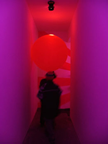October 27, 2006
The Rose Art Museum

Balance and Power: Performance and Surveillance in Video Art
Amid unprecedented concern over privacy and security issues in America and abroad, The Rose Art Museum at Brandeis this fall will feature a look at artists’ uses of surveillance techniques related to performance art and government spying systems. Michael Rush, the Henry and Lois Foster Director of The Rose, will curate the timely exhibit called “Balance and Power: Performance and Surveillance in Video Art.”
“This exhibit examines both the early days of video art as well as current practices,” Rush said. “It’s an attempt to understand the complex relationship between voluntary acting for the camera and involuntary taping by a camera on the part of power systems that have an interest in the movement of citizens.” The exhibition will run Sept. 21 through Dec. 17, 2006.
“Balance and Power” features work by a diverse group of artists, from early video pioneers such as Andy Warhol, Vito Acconci, and Bruce Naumann, to emerging practitioners such as Jill Magid and Tim Hyde. Other international artists are Sophie Calle, Jim Campbell, Peter Campus, Jordan Crandall, Harun Farocki, Subodh Gupta, Kevin Hamilton, Tiffany Holmes, Paul Kaiser and Shelley Eshkar, Kristin Lucas, Steve Mann, Jenny Markatou, Jonas Mekas, Muntadas, Martha Rosler, Julia Scher, and Kiki Seror.
Balance, says Rush, can be described as “an essential talent for the performer,” while power is “the essential currency of surveillance.” The terms are interconnected through themes such as “star” culture, identity theft, privacy and cultural paranoia, he said.
Many of these psycho-social phenomena are reflected in the current mega success of reality TV. “People voluntarily allow themselves to be taped openly and surreptitiously. Surveillance becomes performance and vice versa,” Rush said.
The exhibit will feature a dozen video installations in a uniquely designed space created by Antenna Design Group in New York. There will be large-scale installations, single channel tapes, and newly commissioned work. The exhibition was originally organized by the Krannert Art Museum at the University of Illinois.
Symposium: Privacy Rites: Space, Surveillance, and Power in Historical Perspective :: Brandeis University :: Wednesday, November 8, 2006
4:00 - 6:30 p.m. :: Levine-Ross, Hassenfeld Conference Center
Co-conveners: Mark Auslander (Anthropology) and Andreas Teuber (Philosophy)
The landmark essay, “The Right to Privacy” (1890) by Louis Brandeis and Samuel Warren, was reportedly inspired by a highly evocative episode: a newspaper photographer climbed over a garden wall to photograph Warren’s daughter’s breakfast wedding party, leading to the image’s mass dissemination across the city. This symposium explores some of the fascinating paradoxes suggested by this telling example. “Privacy” and its twinned antithesis, “surveillance,” emerged out of the intersection of built domestic space and emerging optical technologies of mass reproduction. Note the spatial metaphors in Brandeis and Warren’s anxious prophecy: “numerous mechanical devices threaten to make good the prediction that ‘what is whispered in the closet shall be proclaimed from the house-tops.’” A violation of the core spatial distinction of the modern city, the tenuous distinction between public and private, helps catalyze the image of a sacrosanct, sovereign self that is in principle beyond the gaze of sovereign state power or the untrammeled forces of the market.
In this symposium we will reflect upon the broader historical antecedents, resonances, and implications of Brandeis and Warren’s anxious plea. For some theorists, the accelerating proliferation of optical and electronic technologies of surveillance and mechanical reproduction exemplifies a postmodern decoupling of space and power. Bentham’s Panopticon depended on fixed architectural structures, binding together warden and prisoner, the routinzer and the routinized, in intimate disciplines of mutual engagement and physical proximity. In contrast, the synthesis of electronic surveillance, mass mechanical reproduction, and complex information networks seems to promise power that is entirely “extraterritorial,” in which controlling elites are fluid, inaccessible, and no longer spatially entangled with their subordinates. In turn, other scholars insist, sophisticated technologies of remote or virtual monitoring do not transcend space and place as such, but are rather embedded in shifting forms of architecture, landscape, selfhood, and embodiment that are themselves the products of complex social and material histories.
Participants include:
Mark Auslander (Anthropology)
Alex Green (Brandeis '04; owner, Book Pages Books)
Caren Irr (English and American Literature)
Laurie Kain Hart (Anthropology, Haverford College)
Peter Kalb (Fine Arts)
Alice Kelikian (History)
Tom King (English and American Literature)
Ann Koloski-Ostrow (Classics)
Adrianne Krstansky (Theater Arts)
Laura Miller (Sociology)
Rick Parmentier (Anthropology)
John Plotz (English and American Literature)
Michael Rush (Director, Rose Art Museum)
Ellen Schattchneider (Anthropology)
Dr. Ramie Targoff (English and American Literature)
Andreas Teuber (Philosophy)
Jonathan Unglaub (Fine Arts)
Michaele Whelan (English and American Literature)
Discuss Privacy and Surveillance
http://culturalproduction.wikispaces.com/Surveillance+and+Privacy+Comments
About the Rose Art Museum at Brandeis
Opened in 1961, The Rose Art Museum has one of the most distinguished collections of modern and contemporary art in New England. Each year, The Rose organizes highly acclaimed special exhibitions and collection displays, presenting a mix of international, national and local artists.
Rose Art Museum
Brandeis University
415 South Street
Waltham, MA 02453
Posted by jo at October 27, 2006 06:11 PM
